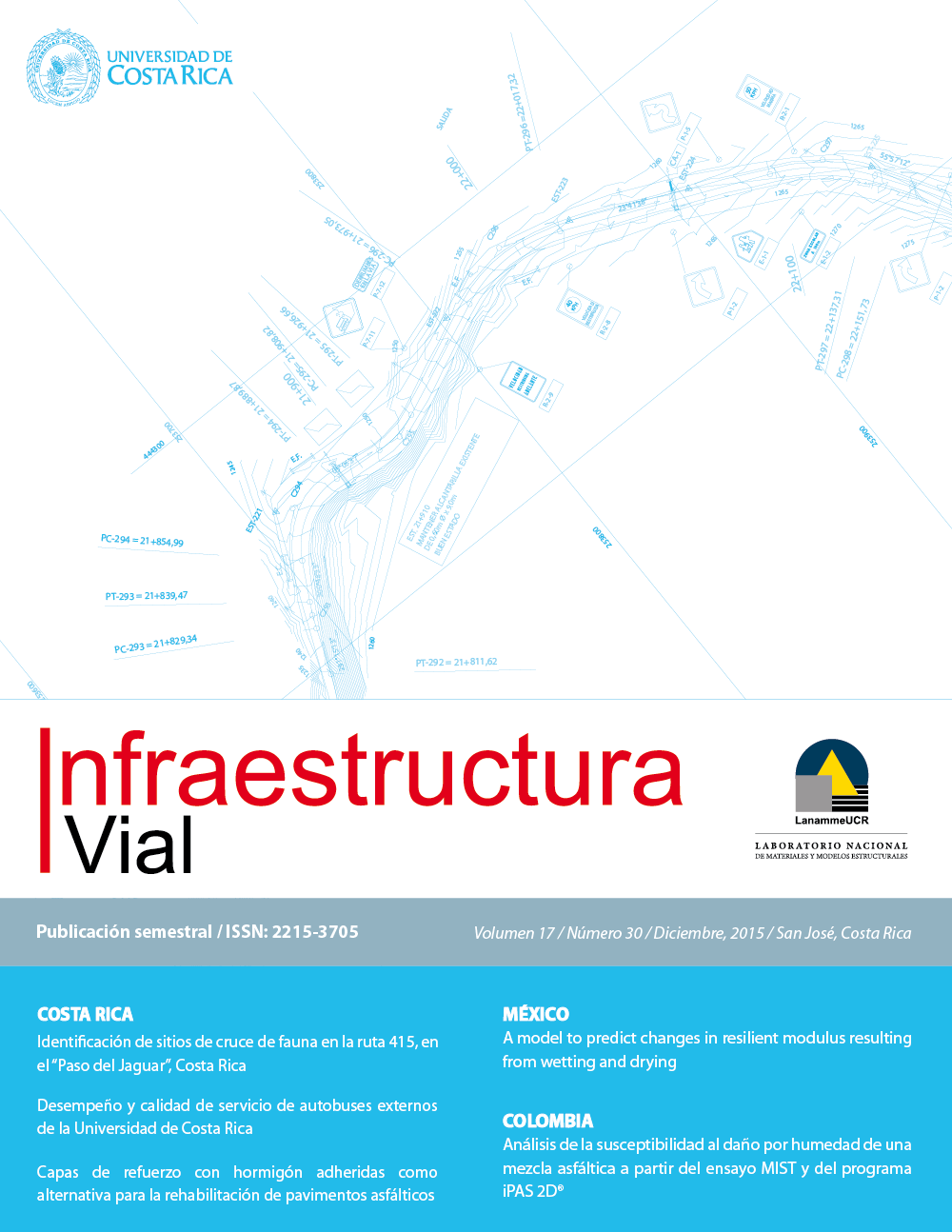Resumen
El daño por humedad es uno de los problemas más comunes en los pavimentos asfálticos en países tropicales y en zonas expuestas a periodos prolongados de lluvia. Esta investigación presenta los resultados de la susceptibilidad a la humedad de una mezcla asfáltica para rodadura, diseñada por la metodología Superpave® y fabricada con ocho tipos de asfalto sujetos a un proceso controlado de oxidación. Adicionalmente se presentan resultados de desempeño de la mezcla asfáltica en relación con el daño por humedad en Moisture Induced Sensitivity Test-MIST y su análisis a través de imágenes con el programa iPAS 2D®, desarrollado por el grupo MARC, Universidad de Wisconsin –Madison y liderado por el profesor Hussain Bahia. Los resultados indican un mayor porcentaje de pérdida de resistencia a la tracción cuando las mezclas se ensayan en el equipo MIST respecto al ensayo Tensile Strength Ratio-TSR. De igual forma, el análisis con imágenes muestra la evolución de pérdida de contacto de los agregados de acuerdo con los diferentes periodos de oxidación y su relación con la susceptibilidad a la humedad MIST.
Citas
ASTM, A., Test, W. A., Test, C. S., & Test, A. R. (1950). American Society for Testing and Materials (ASTM).
American Association of State Highway and Transportation Officials-AASHTO Standards
Buchanan, M. S., & Moore, V. M. (2005). Laboratory accelerated stripping simulator for hot mix asphalt (No. FHWA/MS-DOT-RD-04-167,).
Chen, X., & Huang, B. (2008). Evaluation of moisture damage in hot mix asphalt using simple performance and superpave indirect tensile tests. Construction and Building Materials, 22(9), 1950-1962.
Cubillos Carlos & Nuñez Camila. Análisis de la susceptibilidad al daño por humedad de una mezcla asfáltica para rodadura empleando asfaltos sumergidos. Pontificia Universidad Javerina. 2014.
Figueroa, A., Velasquez, R., Reyes, F., & Bahia, H. (2013). Effect of Water Conditioning for Extended Periods on the Properties of Asphalt Binders.Transportation Research Record: Journal of the Transportation Research Board, (2372), 34-45.
Instituto Nacional de Vías –INVIAS –Normas 2007.Colombia.
Kanitpong, K., & Bahia, H. (2005). Relating adhesion and cohesion of asphalts to the effect of moisture on laboratory performance of asphalt mixtures. Transportation Research Record: Journal of the Transportation Research Board, (1901), 33-43.
Kennedy, T. W.; Roberts, F. L.; and Anagnos, J. N. (1984). Research Report 253-5, Center for Transportation Research, University of Texas at Austin.
Lottman, R. P. (1971). The moisture mechanism that causes asphalt stripping in asphaltic pavement mixtures.
Masad, E., Muhunthan, B., Shashidhar, N., & Harman, T. (1999a). Internal structure characterization of asphalt concrete using image analysis. Journal of computing in civil engineering, 13(2), 88-95.
Masad, E., Muhunthan, B., Shashidhar, N., & Harman, T. (1999b). Quantifying laboratory compaction effects on the internal structure of asphalt concrete.Transportation Research Record: Journal of the Transportation Research Board, (1681), 179-185.
Sefidmazgi, N. R., Tashman, L., & Bahia, H. (2012). Internal structure characterization of asphalt mixtures for rutting performance using imaging analysis. Road materials and pavement design, 13(sup1), 21-37.
Solaimanian, M., Harvey, J., Tahmoressi, M., & Tandon, V. (2003, February). Test methods to predict moisture sensitivity of hot-mix asphalt pavements. In Transportation Research Board National Seminar. San Diego, California (pp. 77-110).
Tunnicliff, D. G.; and Root, R. E. (1984). “Use of Anti-Stripping Additives in Asphaltic Concrete Mixtures”. NCHRP Report 274, Laboratory Phase, TRB, National Research Council, Washington, D.C.
Xinjun Li, Nelson Gibson, Evaluation Moisture Induced Sensitivity Test (MIST) Device: Comparison and Contrast with AASHTO T 283, FHWA, Draft Report.2010.


